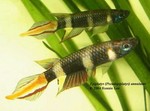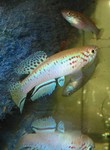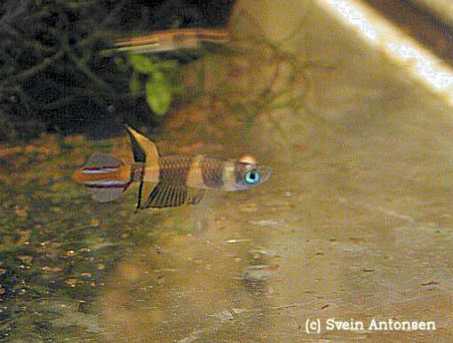Yours look a lot more like the Monrovias we used to have in BAKA. The only difference was that ours had the red pectorals and ventrals shown on Tim's page at the top. We lost that strain, when Wayland Lee and Robert Nhan dropped out of the hobby.
Last year, we obtained about 12-15 of these from Europe for WCW XII. I hogged about 6 or 7 and Don Greig got several.
Don moved to Oregon and never really got his going, while mine were all killed in a fishroom calamity, while being tended by a friend.
I found some semi-neglected ones in LA and got them sent to me this spring. Unfortunately, they didn't have enough strength, left, so I lost them all.  AFAIK, that was all we had, here. [BTW, they were in very hard water at over 700ppm tds when I got them.
AFAIK, that was all we had, here. [BTW, they were in very hard water at over 700ppm tds when I got them.  ]
]
Keep a close eye on them as they mature. If they do get the red paired fins, too, I want some in the worst way. I feel that the WCW XII style of ANN is much better than what we currently have in the hobby, here. Unfortunately, there have been several subsequent commercial imports from Monrovia of colorless ANN, so I started distinguishing the WCW XII fish as "Monrovia Red." Any remaining original "reds" were probably hybridized with the others, for I cannot find any with colored paired fins any more, and none with the gaudy red anal fin.
Keep us posted, please.
Wright
01 760 872-3995
805 Valley West Circle
Bishop, CA 93514 USA
AFAIK, that was all we had, here. [BTW, they were in very hard water at over 700ppm tds when I got them.
]

















 Reply With Quote
Reply With Quote
 .As always, depending on your choice, the AKA FEL will reach only AKA members, but on AquaBid you'll be reaching alot more people. :wink:
.As always, depending on your choice, the AKA FEL will reach only AKA members, but on AquaBid you'll be reaching alot more people. :wink:






 )
)
 So what are the species you're currently keeping, if you don't mind sharing.
So what are the species you're currently keeping, if you don't mind sharing.

Bookmarks